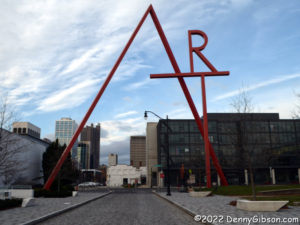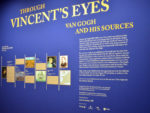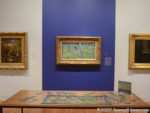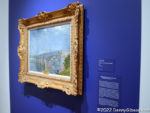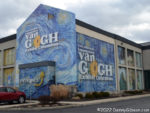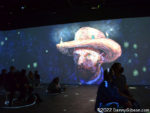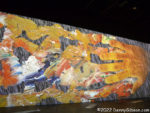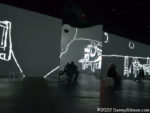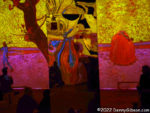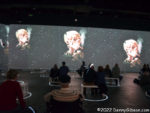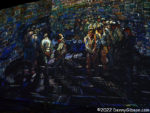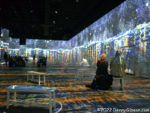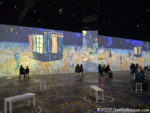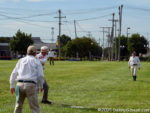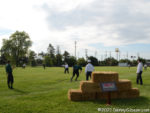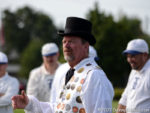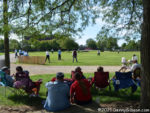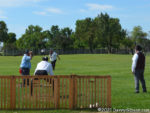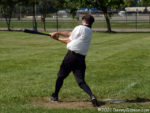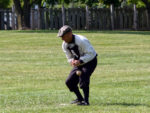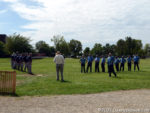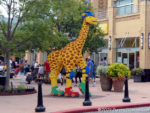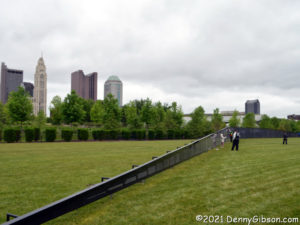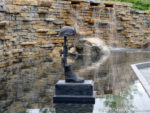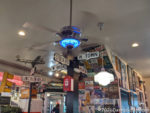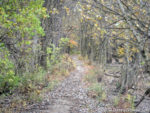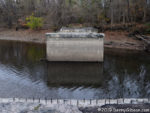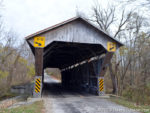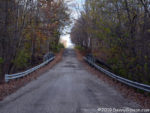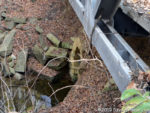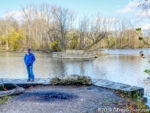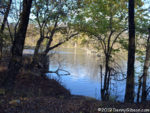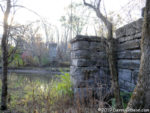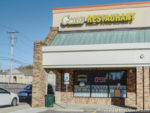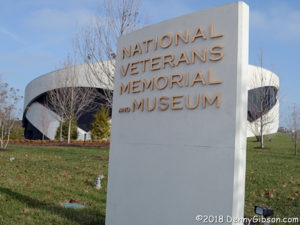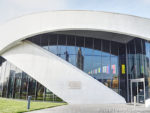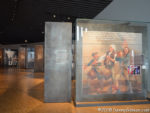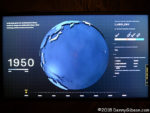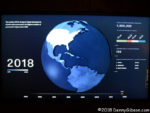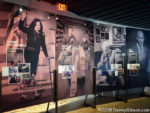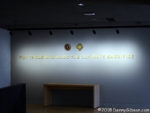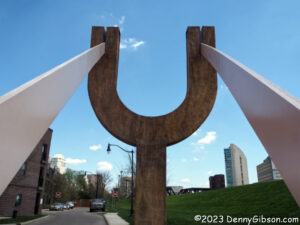 I attended my sixth road meet yesterday which provided a good topic for this week’s post while simultaneously removing any possibility of completing a post about it by 6:00 AM today. Rather than posting a canned article to meet the 6:00 schedule, I decided to defy the self-imposed deadline and post this report on the Columbus Road Meet at whatever time it was complete. Whether or not it is worth waiting for is not for me to say.
I attended my sixth road meet yesterday which provided a good topic for this week’s post while simultaneously removing any possibility of completing a post about it by 6:00 AM today. Rather than posting a canned article to meet the 6:00 schedule, I decided to defy the self-imposed deadline and post this report on the Columbus Road Meet at whatever time it was complete. Whether or not it is worth waiting for is not for me to say.
 The group gathered at Tommy’s Diner for a pre-tour meal. Sandor Gulyas, the meet’s organizer, and I are pretty familiar with Tommy’s but it was something new for the other four attendees. Being there for lunch was also something new for me since I believe all of my previous visits had been for breakfast. I was prepared to order a sandwich when the menu reminded me of the “breakfast all day” policy. It was not quite noon when I tackled a 3-cheese omelet.
The group gathered at Tommy’s Diner for a pre-tour meal. Sandor Gulyas, the meet’s organizer, and I are pretty familiar with Tommy’s but it was something new for the other four attendees. Being there for lunch was also something new for me since I believe all of my previous visits had been for breakfast. I was prepared to order a sandwich when the menu reminded me of the “breakfast all day” policy. It was not quite noon when I tackled a 3-cheese omelet.
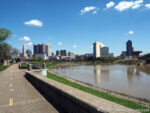
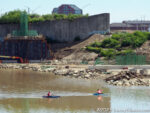
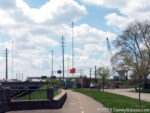 Our first stop was at the Dodge Skatepark from where we could see some of the ongoing construction of a new ramp to I-70/I-71. I’m always something of the odd man at these meets since they lean toward the new and my interest leans toward the old. Of course, it’s really a continuum and I always find something that interests me. However, it might explain why my pier picture includes kayakers and I have a skyline picture facing away from the construction entirely.
Our first stop was at the Dodge Skatepark from where we could see some of the ongoing construction of a new ramp to I-70/I-71. I’m always something of the odd man at these meets since they lean toward the new and my interest leans toward the old. Of course, it’s really a continuum and I always find something that interests me. However, it might explain why my pier picture includes kayakers and I have a skyline picture facing away from the construction entirely.

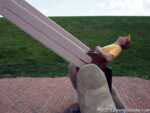 While stopped at the skatepark, we walked over to an art installation named The Slingshot for a group photo. I don’t yet have access to that photo (I’ll add it when I do.) but I do have this picture of Sandor about to be launched in the direction of downtown and the opening photo shows Sandor’s final pre-launch view. ADDENDUM 16-Apr-2023: The group photo has been added at the end of this post.
While stopped at the skatepark, we walked over to an art installation named The Slingshot for a group photo. I don’t yet have access to that photo (I’ll add it when I do.) but I do have this picture of Sandor about to be launched in the direction of downtown and the opening photo shows Sandor’s final pre-launch view. ADDENDUM 16-Apr-2023: The group photo has been added at the end of this post.

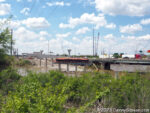
 We then circled through downtown for a view of the construction from the south side of the Sciota River. I was quite impressed with the stationery supervisor watching over things from the hilltop with the tip of the LeVeque Tower peeking up behind him. There’s a closer look here.
We then circled through downtown for a view of the construction from the south side of the Sciota River. I was quite impressed with the stationery supervisor watching over things from the hilltop with the tip of the LeVeque Tower peeking up behind him. There’s a closer look here.
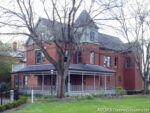
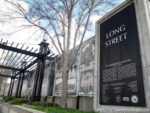
 The brick house is where author James Thurber grew up. It is now a museum and the area around it is called Thurber Village. A parking lot there was our base for a walk to the murals on the Long Street I-71 overpass.
The brick house is where author James Thurber grew up. It is now a museum and the area around it is called Thurber Village. A parking lot there was our base for a walk to the murals on the Long Street I-71 overpass.
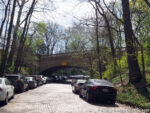
 This pair of bridges bracket a brick-paved section of Iuka Avenue running through Iuka Ravine. The Summit Avenue Bridge (least cars) was built in 1916 and restored in 2001. The Indianola Avenue Bridge was built in 1996 to replace one built in 1912. Kudos for retaining the original appearance of both bridges.
This pair of bridges bracket a brick-paved section of Iuka Avenue running through Iuka Ravine. The Summit Avenue Bridge (least cars) was built in 1916 and restored in 2001. The Indianola Avenue Bridge was built in 1996 to replace one built in 1912. Kudos for retaining the original appearance of both bridges.
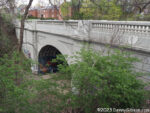
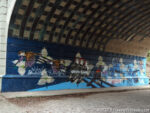 Here are outside and inside pictures of Glen Echo Bird Tunnel on Indianola Avenue. The inside shot should make the difference between art and graffiti quite clear to anyone. If I was younger and lived closer, I’d definitely be making plans for the next Bird Tunnel Party. I’ll probably give it some thought anyway. There are photos of some individual birds here, here, and here.
Here are outside and inside pictures of Glen Echo Bird Tunnel on Indianola Avenue. The inside shot should make the difference between art and graffiti quite clear to anyone. If I was younger and lived closer, I’d definitely be making plans for the next Bird Tunnel Party. I’ll probably give it some thought anyway. There are photos of some individual birds here, here, and here.
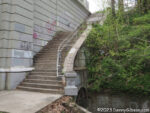

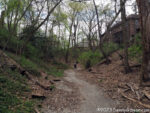 Remnants of the old pavement can be followed to a still-functioning Glen Echo Drive on the other side of Arcadia Avenue. I again gripped the handrail returning to Indianola despite having a different opinion of that bottom column than I had coming down.
Remnants of the old pavement can be followed to a still-functioning Glen Echo Drive on the other side of Arcadia Avenue. I again gripped the handrail returning to Indianola despite having a different opinion of that bottom column than I had coming down.
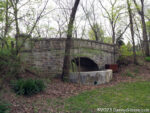
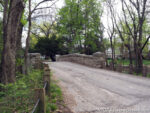
 Formally named Rustic Bridge, this structure was part of a short-lived zoo and amusement park more than a century ago. The zoo was pretty much a failure and closed in 1907 after just four years of existence. My joke about the bartender not being in till later was pretty much a failure too. From the vantage point of the bridge, I thought this looked exactly like four guys hanging out at a bar but I guess it didn’t make the same impression from ground level.
Formally named Rustic Bridge, this structure was part of a short-lived zoo and amusement park more than a century ago. The zoo was pretty much a failure and closed in 1907 after just four years of existence. My joke about the bartender not being in till later was pretty much a failure too. From the vantage point of the bridge, I thought this looked exactly like four guys hanging out at a bar but I guess it didn’t make the same impression from ground level.
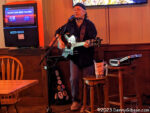

 Following our return to Tommy’s, I headed west on US-40/National Road to the recently reopened Red Brick Tavern. After being closed for nearly four years, this historic tavern had a Grand (re)Opening on Valentine’s Day and less than two months later it appears to be off to a great start. I didn’t catch the musician’s name but I did enjoy his mix of music and I also enjoyed my salmon Ceasar salad. Welcome back!
Following our return to Tommy’s, I headed west on US-40/National Road to the recently reopened Red Brick Tavern. After being closed for nearly four years, this historic tavern had a Grand (re)Opening on Valentine’s Day and less than two months later it appears to be off to a great start. I didn’t catch the musician’s name but I did enjoy his mix of music and I also enjoyed my salmon Ceasar salad. Welcome back!
Apparently, I did not publish a report on that first road meet in 2011 but here are the others:
2012 — Dayton, Ohio
2013 — Cincinnati, Ohio
2019 — Portsmouth, Ohio
2019 — Delaware County, Ohio
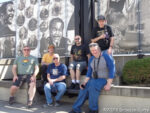
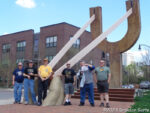 ADDENDUM 16-Apr-2023: Here is the Slingshot group photo plus one on Long Street that I had not mentioned. Thanks, Brandon.
ADDENDUM 16-Apr-2023: Here is the Slingshot group photo plus one on Long Street that I had not mentioned. Thanks, Brandon.

